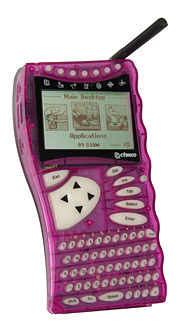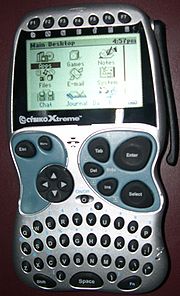
Cybiko
Encyclopedia

Freeware
Freeware is computer software that is available for use at no cost or for an optional fee, but usually with one or more restricted usage rights. Freeware is in contrast to commercial software, which is typically sold for profit, but might be distributed for a business or commercial purpose in the...
games and applications. Because of the text messaging system, it features a QWERTY Keyboard that was used with a stylus. An MP3 player add-on was made for the unit as well as a SmartMedia card reader. The company stopped manufacturing the units after two product versions and only a few years on the market. However, because of the unique radio messaging hardware there is still a hobbyist community using Cybiko.
Cybikos can communicate with each other up to a maximum range of 300 metres (0.19 miles). Several Cybikos can chat with each other in a wireless chatroom.
Cybiko Classic

Firmware
In electronic systems and computing, firmware is a term often used to denote the fixed, usually rather small, programs and/or data structures that internally control various electronic devices...
.
The CPU is a Hitachi H8S/2241 at 11.0592 MHz and it also has an Atmel AT90S2313 co-processor at 4 MHz to provide some support for RF communications. It came with 512 KB ROM flash memory
Flash memory
Flash memory is a non-volatile computer storage chip that can be electrically erased and reprogrammed. It was developed from EEPROM and must be erased in fairly large blocks before these can be rewritten with new data...
and 256 KB RAM. It came with an add-on slot in the back.
The Cybiko Classic came in five colors: blue, purple (very common), neon green (or yellow, as some say), white (the last two are common but less so than blue and purple), and the ultra-rare black Cybiko, which, unlike the others, had a yellow keypad instead of white.
The add-on slot has the same physical appearance (pin-count, spacing) as PC card
PC card
In computing, PC Card is the form factor of a peripheral interface designed for laptop computers. The PC Card standard was defined and developed by the Personal Computer Memory Card International Association which itself was created by a number of computer industry companies in the United States...
, but it is not compatible.
Cybiko Xtreme
The Cybiko Xtreme is the 2nd-generation Cybiko handheld. It boasts many improvements over the "classic" Cybiko, such as a faster processor, more RAM, more ROM, a new OS, a new keyboard layout and case design, greater wireless range, a microphone, improved audio output, and smaller size.The CPU is a Hitachi H8S/2323 at 18 MHz and it also has an Atmel AT90S2313 co-processor at 4 MHz to provide some support for RF communications. It came with 512 KB ROM flash memory
Flash memory
Flash memory is a non-volatile computer storage chip that can be electrically erased and reprogrammed. It was developed from EEPROM and must be erased in fairly large blocks before these can be rewritten with new data...
and 1.5 MB RAM. It came with an add-on slot in the back, but the only hardware released was an MP3 player.
MP3 player
Classic MP3 PlayerThe MP3 player for the Classic plugs into the bottom of the Cybiko, it used Smart Media cards, with a maximum size of 64mb. The player had built in controls. These are relatively easy to find.
Xtreme MP3 Player
The MP3 player plugs into the back of the Cybiko Xtreme. It has a slot for one MMC memory card
MultiMediaCard
The MultiMediaCard is a flash memory memory card standard. Unveiled in 1997 by Siemens AG and SanDisk, it is based on Toshiba's NAND-based flash memory, and is therefore much smaller than earlier systems based on Intel NOR-based memory such as CompactFlash. MMC is about the size of a postage...
or one SD memory Card. The maximum size limit has been found to be 256MB for MMC and 1GB+ for SD. The MP3 player can only be controlled from the Cybiko. Memory from the MP3 player can also be addressed from the Cybiko and used for data and program storage. Due to the fact these devices are no longer manufacturered the only way to obtain them is through a private sale.
1MB Expansion Memory
The memory expansion card plugs in the back of the Cybiko. It provides 1 megabyte of static RAMRam
-Animals:*Ram, an uncastrated male sheep*Ram cichlid, a species of freshwater fish endemic to Colombia and Venezuela-Military:*Battering ram*Ramming, a military tactic in which one vehicle runs into another...
and 1 megabyte of data flash memory. The RAM allows programs with larger memory requirements to run. The data flash allows more programs to be stored. Some Cybiko programs will not run unless the Expansion Memory is plugged in.
Programming the Cybiko
Software for the Cybiko can be programmed in either CC (programming language)
C is a general-purpose computer programming language developed between 1969 and 1973 by Dennis Ritchie at the Bell Telephone Laboratories for use with the Unix operating system....
, or CyBasic, a version of the BASIC programming language with extensions for the Cybiko. Greg Smith of DevCybiko.us created Basic-to-C (Cybiko B2C) - an implementation of the CyBasic language with extensions for floating point math, sprites, music, and 3d graphics (features left out of the very slow CyBasic interpreter). There is also a TCP/KIT which gives the Cybiko Wireless Internet connectivity through a PC-based gateway. These and other projects are available at SourceForge.net.
Support and Third Party Projects
Support for Cybiko has been dropped entirely. The company moved into other lines of business in 2003. There are several fan sites still in existence, and still a few programs being developed by third-party Cybiko developers. In 2001-2002, there were many third-party websites devoted to the handheld. These included Cybla, Canbiko, CybikoMadness, Cybiko HQ, a handful of cybiko websites developed by web developer Mike Mertz, DevCybiko, and Cydevr. These sites included the latest cybiko news, a plethora of third-party downloads, including developed games and add-ons to other games, and many interactive features to unite the Cybiko Community. Once Cybiko Inc.'s downfall began, these once popular sites began to disappear. In November 2006, the official Cybiko site closed down. Today, Planet Cybiko, which was started by community member Picante in 2002, is the final active resource for Cybiko users.Projects
As of October 2004, there is a new kernel for the classic Cybiko called CyBorn that is intended to take advantage of many features in the Cybiko that have been neglected.There have been recent experiments conducted on improving the US Xtreme's RF range. Due possibly to FCC regulations, the US version of the Xtreme is limited to a 500 feet (152.4 meters) outdoor range, while the UK model, at 300 meters (984.25 feet), is nearly double. A solution was found by flashing the US model to the UK firmware. This is not normally possible, but a bug in the PC-Cybiko sync app EZ Loader was found to allow it. Tests have shown a marked improvement in RF communication range after the flash. More Information
Earlier work by KR1ST.COM Allows people to increase the RF power, which means there is no need to flash the unit.
Greg Smith of DevCybiko.us created MiaChat - an AIM wireless client. A Classic Cybiko (the Junction) is wired to the user's PC. Special software (Gateway) runs on the PC that talks to AIM over the Internet. The remote Cybiko (either Classic or Xtreme) then communicates wirelessly with the Junction Cybiko. A buddy list of up to 100 user ids is maintained in a file on the remote Cybiko. Multiple user profiles can be stored on the remote Cybiko. Smith also created QuniciChat for ICQ.

